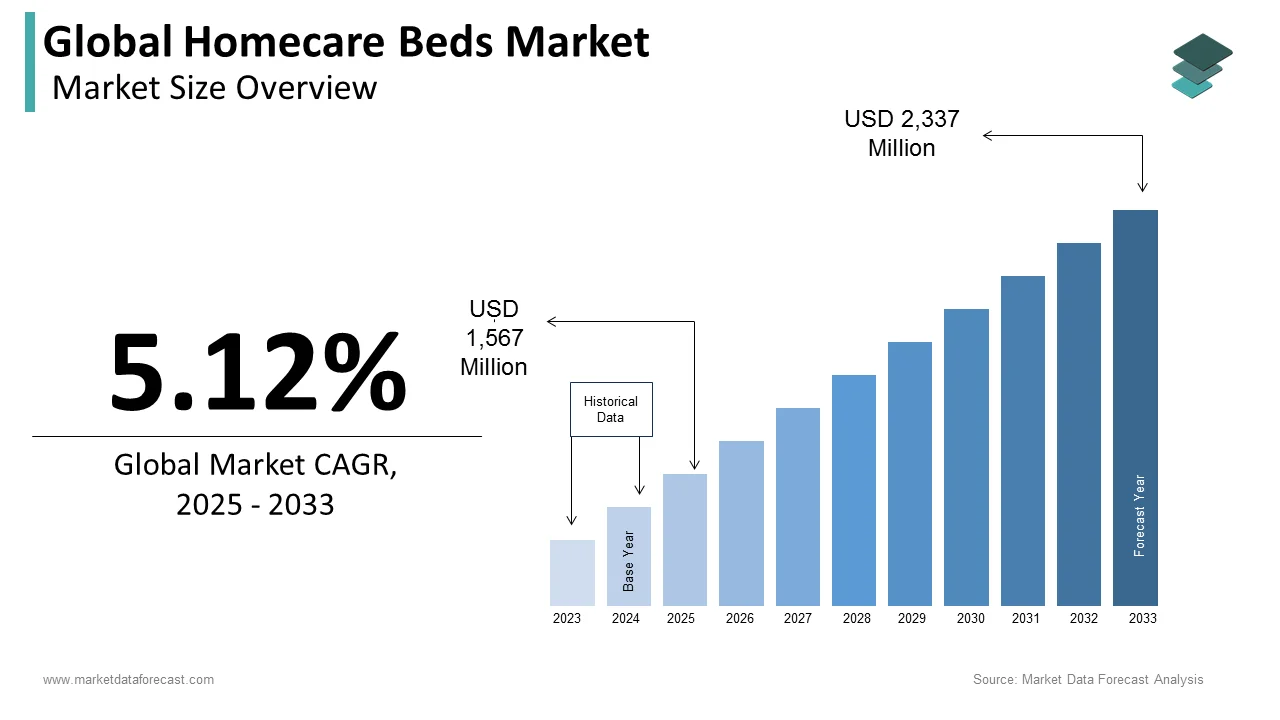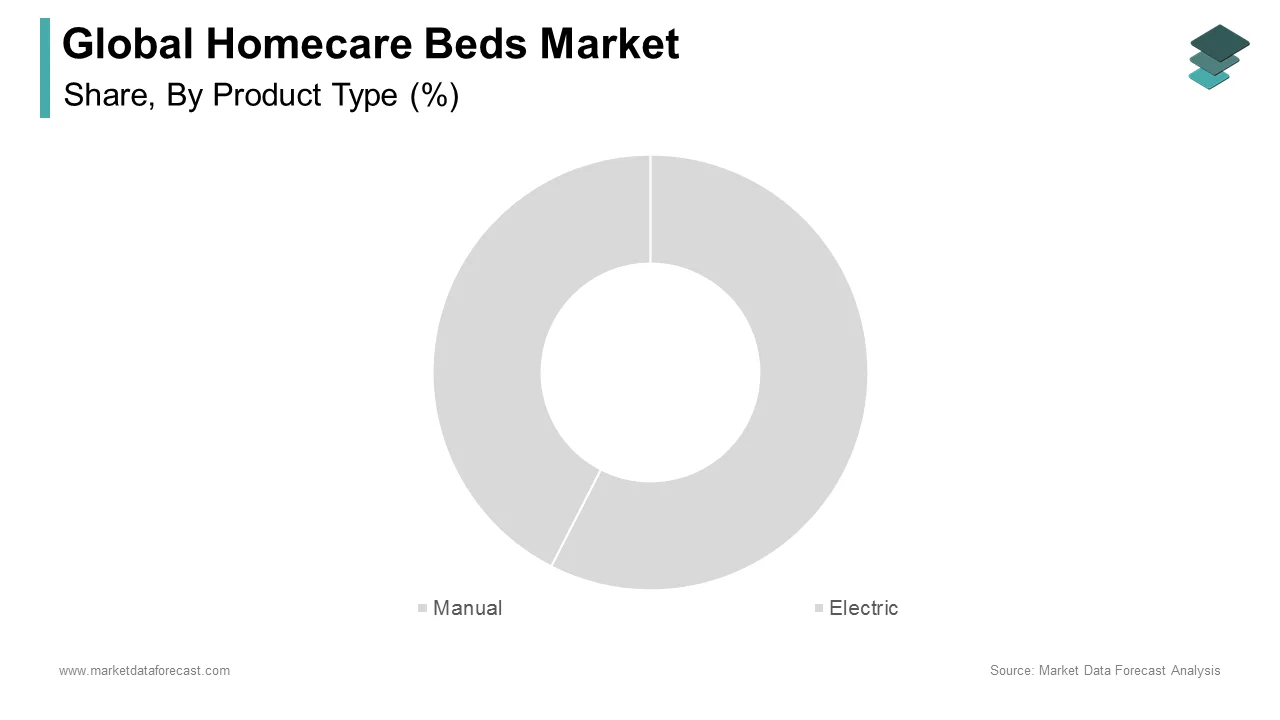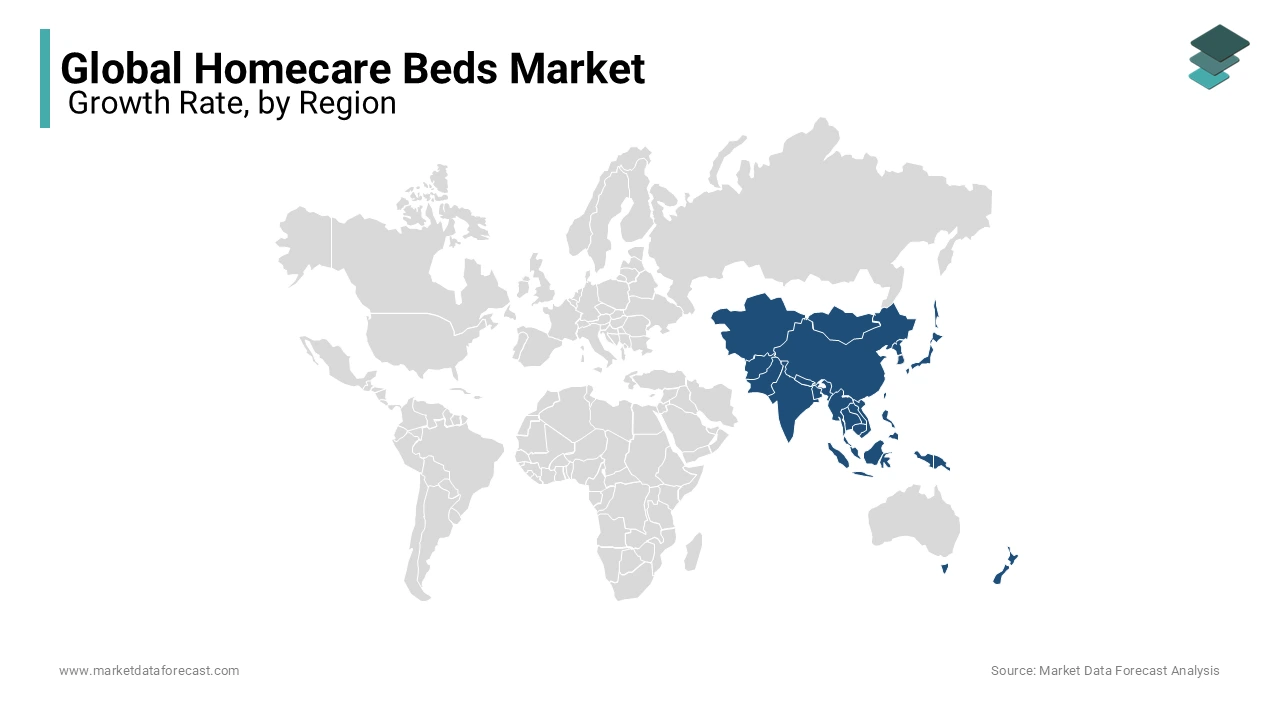Global Homecare Beds Market Size, Share, Trends & Growth Forecast Report By Product Type (Manual Homecare Bed and Electric Homecare Bed), Application (Home, Clinics and Hospitals) and Region (North America, Europe, Asia Pacific, Latin America, Middle East & Africa), Industry Analysis (2025 to 2033)
Global Homecare Beds Market Size
The global homecare beds market size was valued at USD 1,491 million in 2024. The global market is estimated to be growing at a CAGR of 5.12% from 2025 to 2033 and be worth USD 2,337 million by 2033 from USD 1,567 million in 2025.

Homecare beds provide health care benefits for patients, and they are arranged in-home and are like hospital beds. These beds are manufactured with modern features like wheels, elevation, side rails, and others. The beds have controlled the positioning of the foot and head electrically. In addition, the height of the bed can be adjusted either electrically or manually. The design of the beds is very effective, which provides comfort and convenience for the patients.
MARKET DRIVERS
Growing Aging Population Worldwide
The aging population is growing rapidly worldwide. As per the statistics published by the United Nations, the population aged 65 and over is expected to reach 1.5 billion by 2050 worldwide, which was 703 million in 2019. With growing age, people are more likely to get diagnosed with various chronic diseases that require long-term care and assistance. Due to reduced mobility, balance issues, and other age-related health problems, people who are aged face several problems getting in and out of bed. To such people, homecare beds are an effective solution as it offers a safe and comfortable environment for elderly people. In recent years, increased usage of homecare beds by aged people has been noticed and the trend is expected to accelerate in the coming years owing to the rising preference for home healthcare by aged people. In a survey conducted by the American Association of Retired Persons (AARP), around 76% of aged people in America agreed that they would want to take healthcare from the comfort of home. Using home care beds, the aged can take the care that they require by staying in the comfort of their homes. Homecare beds are a cost-effective alternative to getting treatment from the hospital, and due to this, the adoption of homecare beds has grown gradually over the last several years, boosting the market’s growth rate.
Rising Prevalence of Chronic Diseases
The Centers for Disease Control and Prevention (CDC) says 6 in 10 U.S. adults have at least one chronic disease and 4 in 10 suffer 2 or more chronic diseases. The number of people suffering from chronic diseases such as diabetes, cancer, CVDs, COPD, Alzheimer's disease and others is increasing rapidly worldwide. People suffering from chronic diseases are required to take treatments for prolonged periods of time, and these patients like to take treatment from the comfort of home instead of hospital stays. Homecare beds are specially designed for people who take treatment from home and are loaded with several features to provide comfort and safety to the users. Homecare beds further provide a convenient and comfortable environment for patients who need long-term care and offer several features, including height adjustment, position, firmness, and side rails for patient safety. During the COVID-19 pandemic, the adoption of homecare beds by chronic disease patients has increased significantly as people hesitated to go out due to fear of exposure to the virus.
In addition, the rapid adoption of technological developments in the development of innovative and advanced homecare beds, growing healthcare costs, rising adoption of home healthcare and an increasing number of initiatives from several governments to promote the adoption of home healthcare services boost the growth rate of the market. Furthermore, the growing demand for self-medication, increasing disposable income in developed and developing countries, and the rising preference for home-based care further promote the growth of the home care beds market. The presence of favorable reimbursement policies and rising awareness among patients and healthcare providers regarding the benefits of homecare beds are showcasing a favorable impact on the market growth.
MARKET RESTRAINTS
However, the cost of installation and maintenance of these beds is one of the major factors hampering the homecare beds market. In addition, lack of standardization, poor awareness among patients regarding the benefits of using these beds in some countries, the stringent regulatory environment for homecare beds, and the availability of alternative products further inhibit the growth rate of the market.
REPORT COVERAGE
|
REPORT METRIC |
DETAILS |
|
Market Size Available |
2024 to 2033 |
|
Base Year |
2024 |
|
Forecast Period |
2025 to 2033 |
|
Segments Covered |
By Product Type, End-user, and Region |
|
Various Analyses Covered |
Global, Regional, & Country Level Analysis; Segment-Level Analysis, Drivers, Restraints, Opportunities, Challenges; PESTLE Analysis; Porter’s Five Forces Analysis, Competitive Landscape; Analyst Overview of Investment Opportunities |
|
Regions Covered |
North America, Europe, Asia Pacific, Latin America, Middle East & Africa |
|
Market Leaders Profiled |
Paramount Bed, Hill-Rom, Stryker, Linet Group, Stiegelmeyer, Guldmann, ArjoHuntleigh |
SEGMENTAL ANALYSIS
By Product Type Insights

The electric homecare beds segment held the largest share of the global market in 2024 and is expected to grow promisingly during the forecast period. The segmental growth is majorly driven by the benefits of electric homecare beds such as being more convenient than manual beds and can be used with remote control. The safety features of electric homecare beds such as automatic shut-off in case of a power outage or if the bed is overloaded, is further propelling the segmental growth.The manual segment accounted for a considerable share of the global market in 2024. It is expected to grow at a steady CAGR during the forecast period owing to its cost-effectiveness, durability and ease of use.
By End-User Insights
The home segment had the major share of the global market in 2024 and is expected to grow at a notable CAGR during the forecast period. The segmental growth is majorly driven by the growing population suffering from various diseases and rising disposable income. In addition, factors such as the growing need for homecare beds to provide comfortable and safe sleeping arrangements for the aging population, the rising adoption of home healthcare and the cost-effectiveness of homecare beds compared to hospitalizations are driving the segment’s growth rate. The clinic segment is anticipated to grow at a steady CAGR during the forecast period. Factors such as the growing number of outpatient clinics and the rising adoption of outpatient care boost segmental growth. The hospital segment is projected to register a moderate CAGR during the forecast period owing to factors such as increasing demand for acute care and the rising number of hospitals worldwide.
REGIONAL ANALYSIS
North America accounted for the largest share of the worldwide market in 2024, and the regional domination is anticipated to continue throughout the forecast period. The growth of the North American market is majorly driven by the rising prevalence of chronic diseases and the growing geriatric population in North America. As per the projections of the U.S. Census Bureau, the population of 65 and above years is expected to reach 95.7 million by 2060 in the U.S. In addition, the presence of well-established healthcare infrastructure in the North American region, the rising preference for home healthcare due to rising healthcare costs and the rapid adoption of technological advancements in homecare beds, such as smart beds that offer remote monitoring and improved patient comfort further fuel the growth rate of the North American market. The growing trend of telehealth and remote patient monitoring is another significant factor contributing to the growth of the North American market.

Europe had the second-largest share of the worldwide market in 2024 and is estimated to grow at a notable CAGR during the forecast period. Factors such as the growing healthcare expenditure, the presence of sophisticated healthcare infrastructure, and the presence of key market participants such as Arjo, Linet, and Hill-Rom drive the growth of the European market. The increasing prevalence of chronic diseases such as diabetes, cancer, and cardiovascular diseases, the rising adoption of homecare beds among aged people due to better mobility and comfort, and the growing trend of home-based healthcare services further promote the growth of the European market.
APAC is forecasted to witness the fastest CAGR during the forecast period. Factors such as increasing disposable income, growing healthcare expenditure in countries such as China, India, and Japan and increasing awareness regarding homecare beds and their benefits among the patient population drive the market growth in APAC. The increasing adoption of Western lifestyles, the growing prevalence of chronic diseases, and increasing government initiatives to promote home healthcare services boost the growth rate of the APAC market. As per the estimates of the World Health Organization (WHO), an estimated 86% of deaths in the Southeast region are due to chronic diseases.
Latin America held a considerable share of the global market in 2024 and is predicted to witness a healthy CAGR during the forecast period. The growth of the Latin American market is attributed to the growing demand for better healthcare facilities. Brazil and Mexico are predicted to occupy the major share of the Latin American market during the forecast period.
The MEA homecare beds market is expected to showcase a steady CAGR during the forecast period owing to the rising support from the public and private organizations to manufacture homecare beds at an affordable cost.
KEY MARKET PLAYERS
Paramount Bed, Hill-Rom, Stryker, Linet Group, Stiegelmeyer, Guldmann, ArjoHuntleigh, France Bed, BaKare, Gendron, Invacare, Merivaara, Med-Mizer, Haohan, Graham-Field, and NOA Medical Industries are some of the notable companies in the worldwide homecare beds market and profiled in this report.
MARKET SEGMENTATION
This market research report on the global homecare beds market has been segmented and sub-segmented based on the product type, end-user, and region.
By Product Type
- Manual
- Electric
By End-User
- Home
- Clinics
- Hospitals
By Region
- North America
- Europe
- Asia Pacific
- Latin America
- The Middle East and Africa
Frequently Asked Questions
What is the current size of the homecare beds market?
The global homecare beds market size was worth USD 1,491 million in 2024.
What is driving the growth of the homecare beds market?
The growing prevalence of chronic diseases and disabilities, the growing aging population, and the rising demand for home healthcare services majorly drive the homecare beds market growth.
What are some challenges faced by the homecare beds market?
The high cost of homecare beds and accessories, concerns about patient safety and comfort, and the lack of reimbursement for certain types of homecare beds and accessories are challenging the growth of the homecare beds market.
What are the major players in the homecare beds market?
Invacare Corporation, Drive DeVilbiss Healthcare, Hill-Rom Holdings, Inc., and Stryker Corporation are some of the key players in the homecare beds market.
Related Reports
Access the study in MULTIPLE FORMATS
Purchase options starting from $ 2500
Didn’t find what you’re looking for?
TALK TO OUR ANALYST TEAM
Need something within your budget?
NO WORRIES! WE GOT YOU COVERED!
Call us on: +1 888 702 9696 (U.S Toll Free)
Write to us: [email protected]
